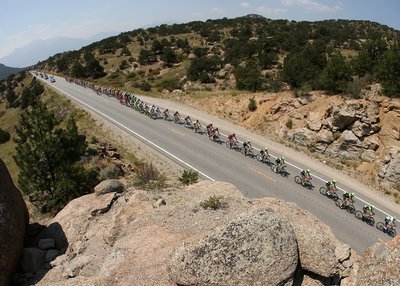
Race Radio: Does Stage Length Matter? The Women's Race Kicks Off
The USA Pro Challenge actually features shorter stages than races in Europe. Some riders believe this creates more intense action along the road.
 You may wonder how anyone could race a bicycle from Copper Mountain to Aspen on one day, and then race from Aspen all the way to Breckenridge the next.
You may wonder how anyone could race a bicycle from Copper Mountain to Aspen on one day, and then race from Aspen all the way to Breckenridge the next.
The cyclists cover an impressive amount of ground during the USA Pro Challenge. But in the world of pro cycling, the USA Pro Challenge’s stages are actually considered to be short.
Just four of the six road stages of this year’s USA Pro Challenge (not including the Stage 5 individual time trial) surpass 100 miles in length. Thursday’s stage into Breckenridge — this year’s longest stage — clocked in at 126 miles.
The Tour de France, by comparison, regularly features stages that stretch beyond 130 miles in length.
The directors of the USA Pro Challenge have purposely chosen shorter stages. There is a growing opinion within the cycling world that shorter stages create more exciting races, since the riders have less distance to execute their various strategies.
“The shorter stages always bring the most action,” says rider Laurent Didier of the Trek Factory Racing Team. “When riders know it’s short, they can make the pace more intense.”
Shorter stages often feature the same dynamics as the longer ones. Aggressive riders attack in the opening miles until a breakaway group forms, and then the team defending the yellow jersey takes charge of the peloton to keep the breakaway from pulling too far ahead. The group often comes back together before the day's decisive climb, and the strongest riders battle it out to the finish line.
When stages are shorter, the riders have more energy left for the decisive final. As fans saw on Thursday, the riders had enough energy to attack up Moonstone Road into Breckenridge, which created an exciting finish.
Charlie Wegelius, team director for Cannondale-Garmin, said that in a shorter stage, the controlling team must worker harder to keep the breakaway from grabbing too much time. With less distance to cover, a breakaway with too much time could survive all the way to the finish line, he said.
“It encourages riders to be more brave and try for breakaways,” Wegelius said. “Here, you can see the breaks rarely get more than three minutes, and the team has to ride very hard behind.”
Australia’s Rohan Dennis, who now leads the race after winning Stage 4 into Breckenridge, says he prefers the shorter stages. Races that stretch over 150 miles, he says, can lull the peloton to sleep, since there is so much ground to cover.
“Being shorter, things are just more aggressive and more exciting,” Dennis said. “We’re playing cat and mouse all day.”
Bike Choice A Factor in Women's Race The USA Pro Challenge’s inaugural women’s race kicks off on Friday with an 8.5-mile individual time trial through Breckenridge. On Saturday, the women tackle a 58-mile stage linking Loveland and Fort Collins, before the race concludes on Sunday with a circuit race in downtown Golden.
The USA Pro Challenge’s inaugural women’s race kicks off on Friday with an 8.5-mile individual time trial through Breckenridge. On Saturday, the women tackle a 58-mile stage linking Loveland and Fort Collins, before the race concludes on Sunday with a circuit race in downtown Golden.
Where will the race be won? Pro women said that the course presents a handful of decisive stretches of road.
“The climb up Rist Canyon [on Saturday] is going to produce a lot of splits in the peloton,” says Meredith Miller, who is riding for the Pepper Palace p/b Happy Tooth team. “And when you head back down to Fort Collins, there are a few hills that could create more gaps.”
The women agreed that Friday’s individual time trial was most likely to establish the race’s hierarchy. The only question, however, is how to approach the course. The route begins with five relatively flat miles before the painful and steep mile-long climb up Moonstone Road. Equipment choice could factor into the race.
A traditional aerodynamic time trial bike gives a major advantage on flatter roads, but the bikes are notoriously slow on climbs. A regular drop-handlebar road bike could help a rider gain ground on the climb, but the round tubing and lack of time aero bars will slow a rider on the flats.
Some riders even proposed changing bikes mid-race from a time trial to a road bicycle.
Kristin Armstrong, the two time Olympic champion in the time trial, said she has yet to decide on her equipment.
“The pre-riding and figuring things out — it’s all part of the process,” Armstrong says. “That’s what makes it fun.
About the author:
Fred Dreier is a journalist living in Denver, Colorado.
He has written about professional bicycle racing since 2004, and his work has appeared in a wide variety of magazines and newspapers, such as The New York Times, The Wall Street Journal and USA Today. Dreier has covered the USA Pro Cycling Challenge since its debut in 2011. He regularly rides his bicycle on many of the roads used by the race.












